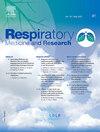Pulmonary Arterial Hypertension-approved drugs in Pulmonary Hypertension associated with COPD: A systematic literature review
IF 1.8
4区 医学
Q3 RESPIRATORY SYSTEM
引用次数: 0
Abstract
Introduction
Pulmonary hypertension (PH) is commonly associated with chronic obstructive pulmonary disease (COPD), with an estimated prevalence of 39%. PH reduces functional capacity and exercise tolerance, and increases the risk of COPD exacerbations and hospitalizations. PH associated with COPD (PH–COPD) typically manifests with moderate severity, progressing gradually in tandem with the level of bronchial obstruction. However, a specific subgroup with severe PH displays disproportionately high pulmonary vascular resistance, reduced diffusion capacity, and a severe prognosis.
Methods
This article is a systematic literature review of clinical trials including randomized controlled trials (RCTs), non-RCTs, cohort studies and registry data regarding PAH-approved drugs, in the context of PH–COPD, from January 2003 to January 2025.
Results
There have been three positive and three negative RCTs with phosphodiesterase-5 inhibitors, as well as one positive and one negative RCT with endothelin receptor antagonists. These RCTs suffered from limitations especially in severe PH cases. Additional data came from 16 studies, including non-RCTs, cohort studies and registry data, and the results were conflicting. The most robust study, a large phase 3 RCT using inhaled treprostinil, was terminated early due to an unfavorable benefit-risk ratio.
Conclusion
The evidence does not support PAH-approved drugs for mild-to-moderate PH–COPD, though potential benefits may exist for the severe PH subgroup. Large, multicenter RCTs are necessary to provide robust medical evidence and phase 2 and phase 3 clinical trials are ongoing. In the interim, suspected or confirmed severe PH–COPD should prompt referral to PH centers for personalized care and potential clinical trial participation.
经批准的肺动脉高压药物治疗COPD相关肺动脉高压:系统文献综述
肺动脉高压(PH)通常与慢性阻塞性肺疾病(COPD)相关,估计患病率为39%。PH降低了功能能力和运动耐受性,增加了COPD恶化和住院的风险。PH与COPD相关(PH - COPD)通常表现为中度严重程度,随支气管阻塞程度逐渐进展。然而,严重PH的特定亚组表现出不成比例的高肺血管阻力,扩散能力降低和严重预后。方法:本文对2003年1月至2025年1月在PH-COPD背景下的pah批准药物的临床试验进行了系统的文献综述,包括随机对照试验(rct)、非rct、队列研究和注册数据。结果磷酸二酯酶-5抑制剂组有3个阳性RCT和3个阴性RCT,内皮素受体拮抗剂组有1个阳性RCT和1个阴性RCT。这些随机对照试验存在局限性,特别是在严重的PH病例中。其他数据来自16项研究,包括非随机对照试验、队列研究和登记数据,结果相互矛盾。最有力的研究是一项使用吸入曲前列替尼的大型3期随机对照试验,由于不利的获益-风险比而提前终止。结论:证据不支持pah批准的药物治疗轻至中度PH - copd,尽管对重度PH亚组可能存在潜在的益处。为了提供强有力的医学证据,需要大型多中心随机对照试验,目前正在进行2期和3期临床试验。在此期间,疑似或确诊的严重PH - copd应及时转诊到PH中心进行个性化护理和潜在的临床试验参与。
本文章由计算机程序翻译,如有差异,请以英文原文为准。
求助全文
约1分钟内获得全文
求助全文
来源期刊

Respiratory Medicine and Research
RESPIRATORY SYSTEM-
CiteScore
2.70
自引率
0.00%
发文量
82
审稿时长
50 days
 求助内容:
求助内容: 应助结果提醒方式:
应助结果提醒方式:


